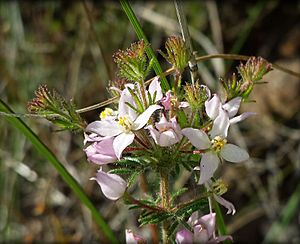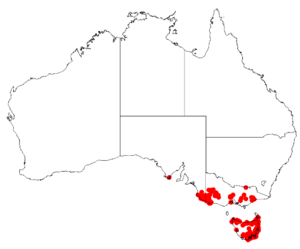Hairy boronia facts for kids
Quick facts for kids Hairy boronia |
|
|---|---|
 |
|
| Boronia pilosa in the Northern Grampians | |
| Scientific classification | |
 |
|
| Occurrence data from Australasian Virtual Herbarium |
The Hairy Boronia (Boronia pilosa) is a unique plant. It belongs to the Rutaceae family, which is the same family as citrus fruits like oranges and lemons! This plant is endemic, meaning it only grows naturally in south-eastern Australia.
It's a woody shrub that stands upright. It has branches covered in fine hairs. Its leaves are special because they are pinnate. This means they have smaller leaflets arranged like a feather. The Hairy Boronia produces groups of white to pink flowers. Each flower has four petals.
Contents
About the Hairy Boronia Plant
The Hairy Boronia is an upright, woody shrub. It can grow to be about 1–2 m (3–7 ft) tall. Its branches are covered in tiny hairs, which gives the plant its name.
Leaves of the Hairy Boronia
The leaves of this plant are pinnate. This means they are divided into smaller parts called leaflets. Each leaf can have three, five, seven, or nine leaflets. The whole leaf can be 3–18 mm (0.1–0.7 in) long and 4–34 millimetres (0.16–1.3 in)* wide.
The leaves connect to the stem with a small stalk called a petiole. This stalk is usually 0.5–3 millimetres (0.020–0.12 in)* long. The leaflet at the very end of the leaf is shaped like a narrow egg. It is about 1–13 millimetres (0.039–0.51 in)* long and 0.5–2.5 millimetres (0.020–0.098 in)* wide. The leaflets on the sides are similar but often a bit longer.
Flowers of the Hairy Boronia
The flowers of the Hairy Boronia are usually white or pink. They grow in groups, often with three to six flowers together. These groups can be found where the leaves meet the stem (called leaf axils) or at the ends of the branches.
Each group of flowers grows on a small stalk called a peduncle. This stalk is usually 0.5–2.5 millimetres (0.020–0.098 in)* long. Each individual flower also has its own tiny stalk, called a pedicel, which is about the same length.
The flowers have four small, triangular parts called sepals. These sepals are about 1–3 millimetres (0.039–0.12 in)* long and 1–2 millimetres (0.039–0.079 in)* wide. They overlap at their bases. There are also four petals, which are the colorful parts of the flower. These petals are 4–7 millimetres (0.16–0.28 in)* long. They fall off before the plant's fruit starts to grow.
Inside the flower, there are eight stamens. Stamens are the parts of the flower that produce pollen. These stamens are also hairy! The Hairy Boronia usually flowers between August and February.
Naming the Hairy Boronia
The scientific name for the Hairy Boronia is Boronia pilosa. This plant was first officially described in 1805 by a scientist named Jacques Labillardière. He wrote about it in his book, Novae Hollandiae Plantarum Specimen.
The second part of the name, pilosa, is a Latin word. It means "hairy," which perfectly describes the plant's hairy branches and stamens!
Different Types of Hairy Boronia
In 2003, another scientist named Marco Duretto studied the Hairy Boronia more closely. He found that there are actually four slightly different types, or subspecies, of Boronia pilosa. These subspecies are:
- Boronia pilosa subsp. parvidaemonis
- Boronia pilosa subsp. pilosa
- Boronia pilosa subsp. tasmanensis
- Boronia pilosa subsp. torquata
Where the Hairy Boronia Lives
The Hairy Boronia grows in different types of natural areas. You can find it in woodlands, which are like forests but with more open spaces. It also grows in heathlands, which are open areas with low-growing shrubs. Sometimes, it even grows in places that are quite exposed to the wind and sun.
You can find the Hairy Boronia in three states in Australia: Victoria, Tasmania, and South Australia.

